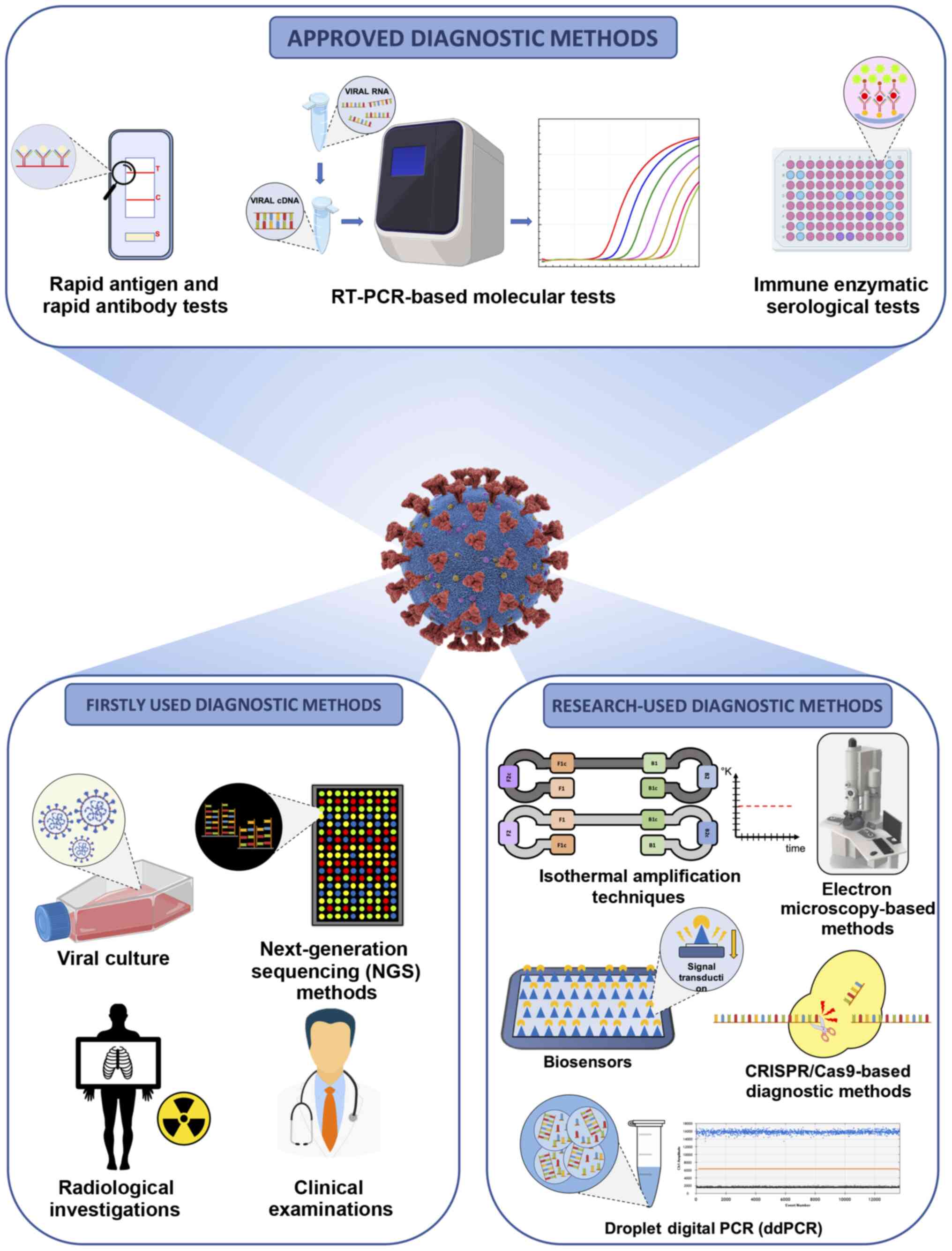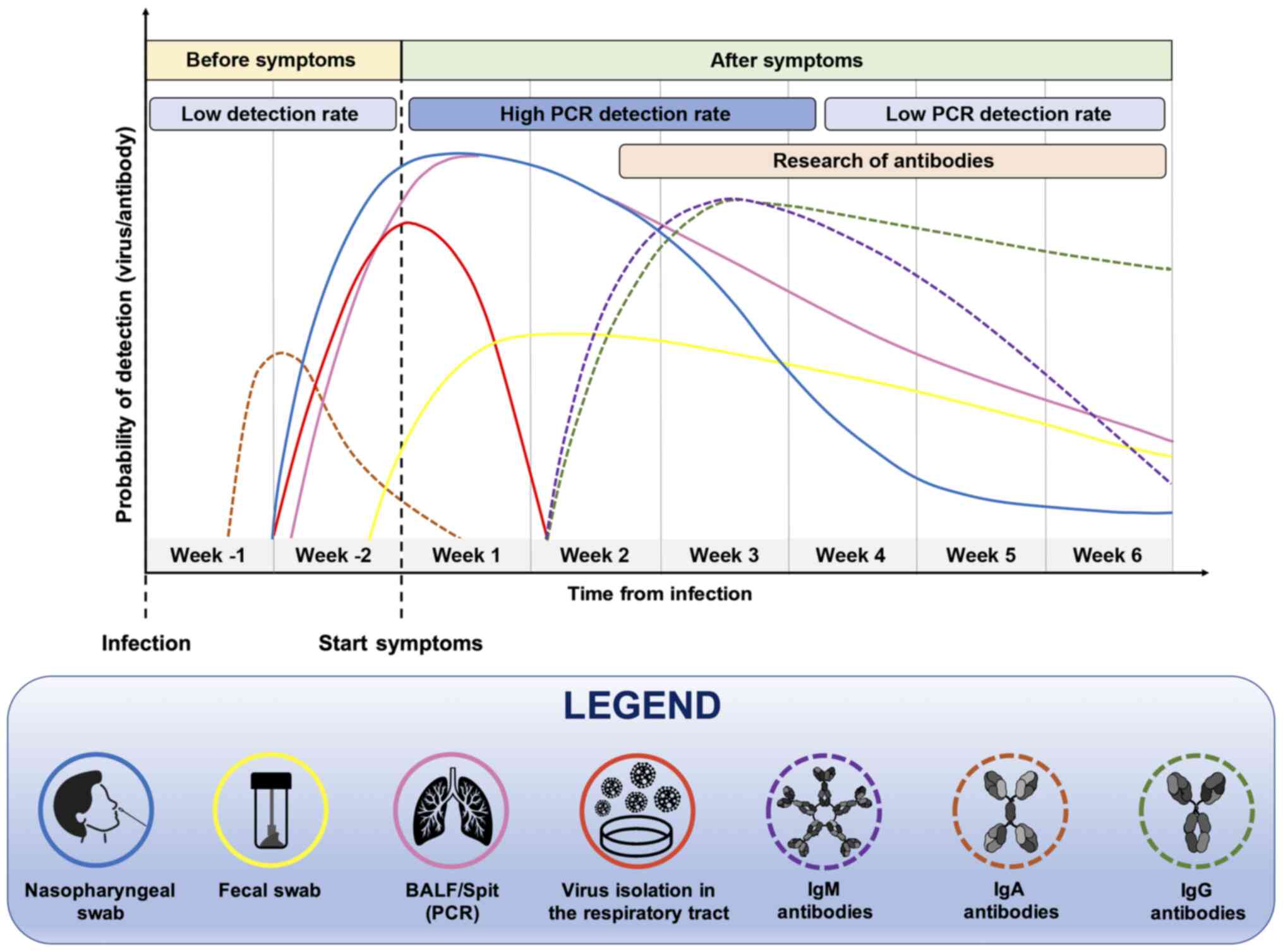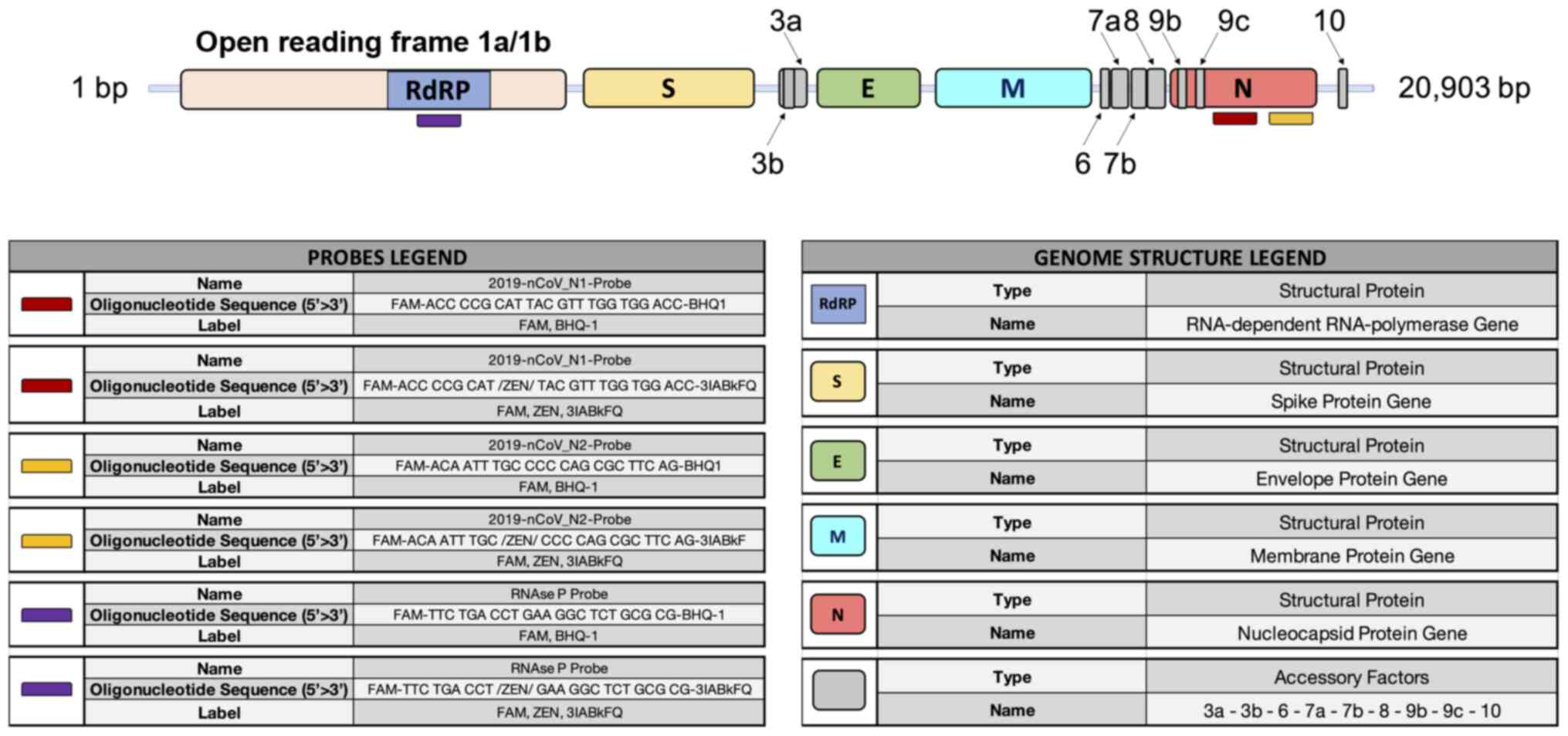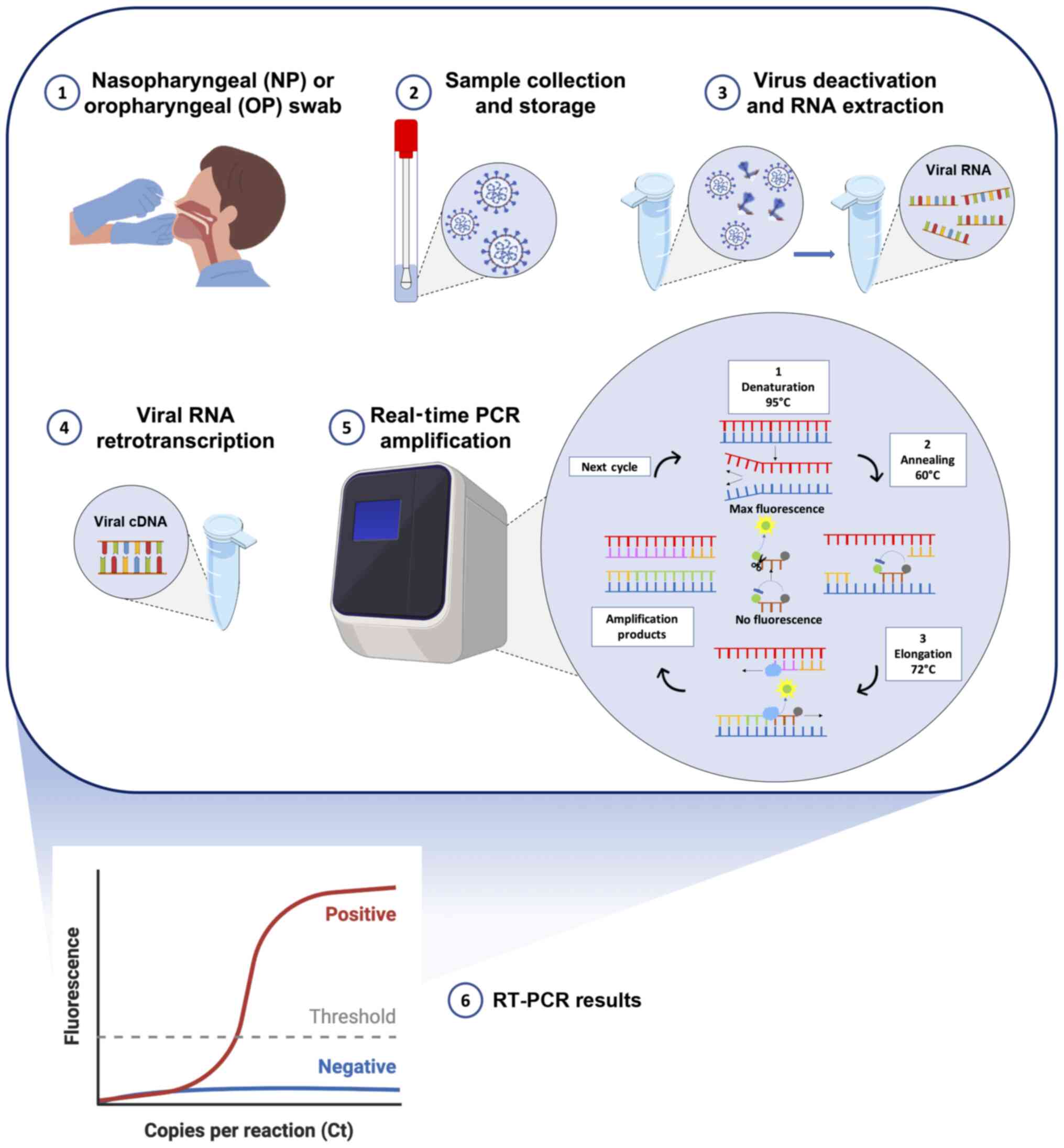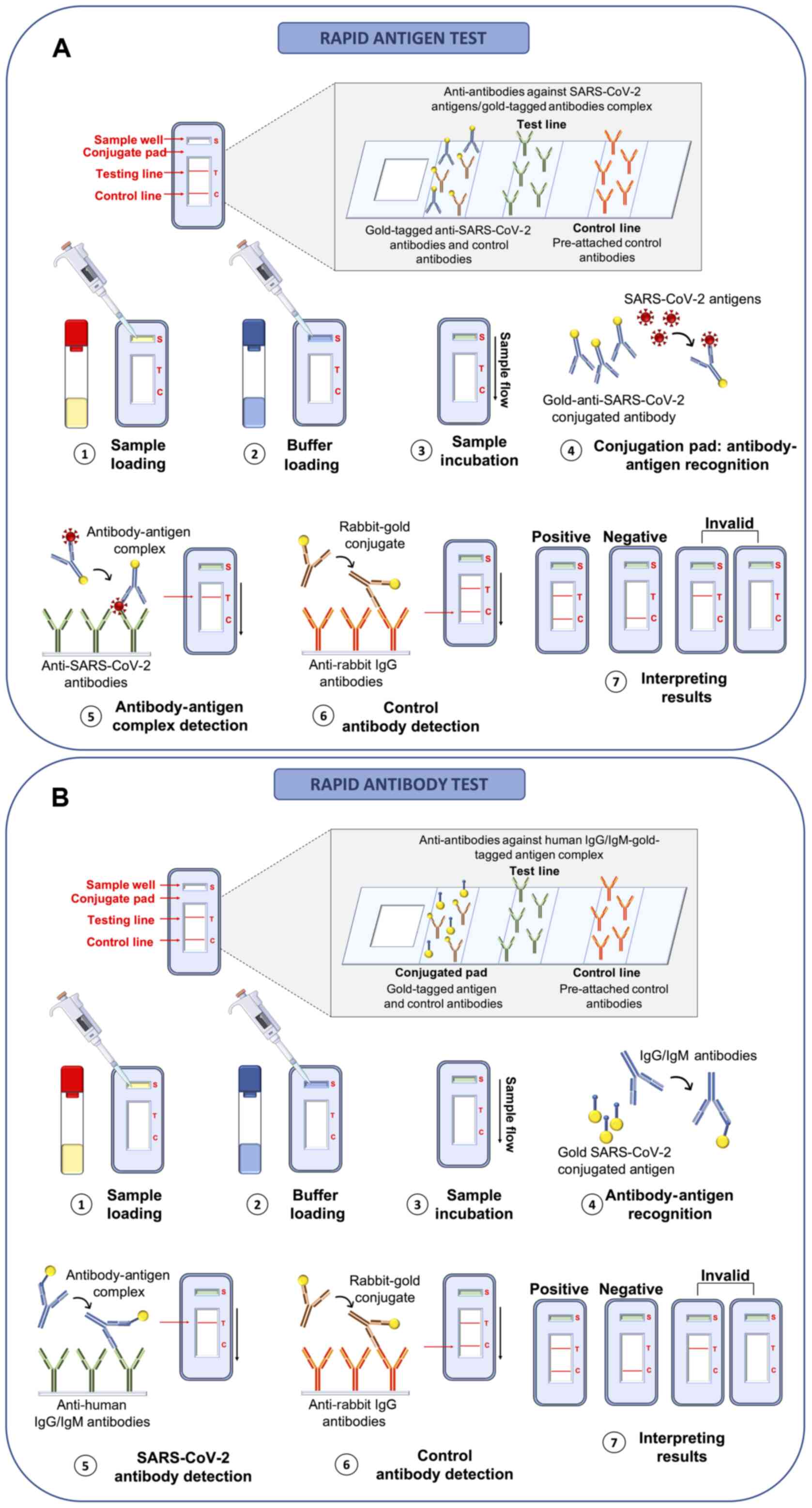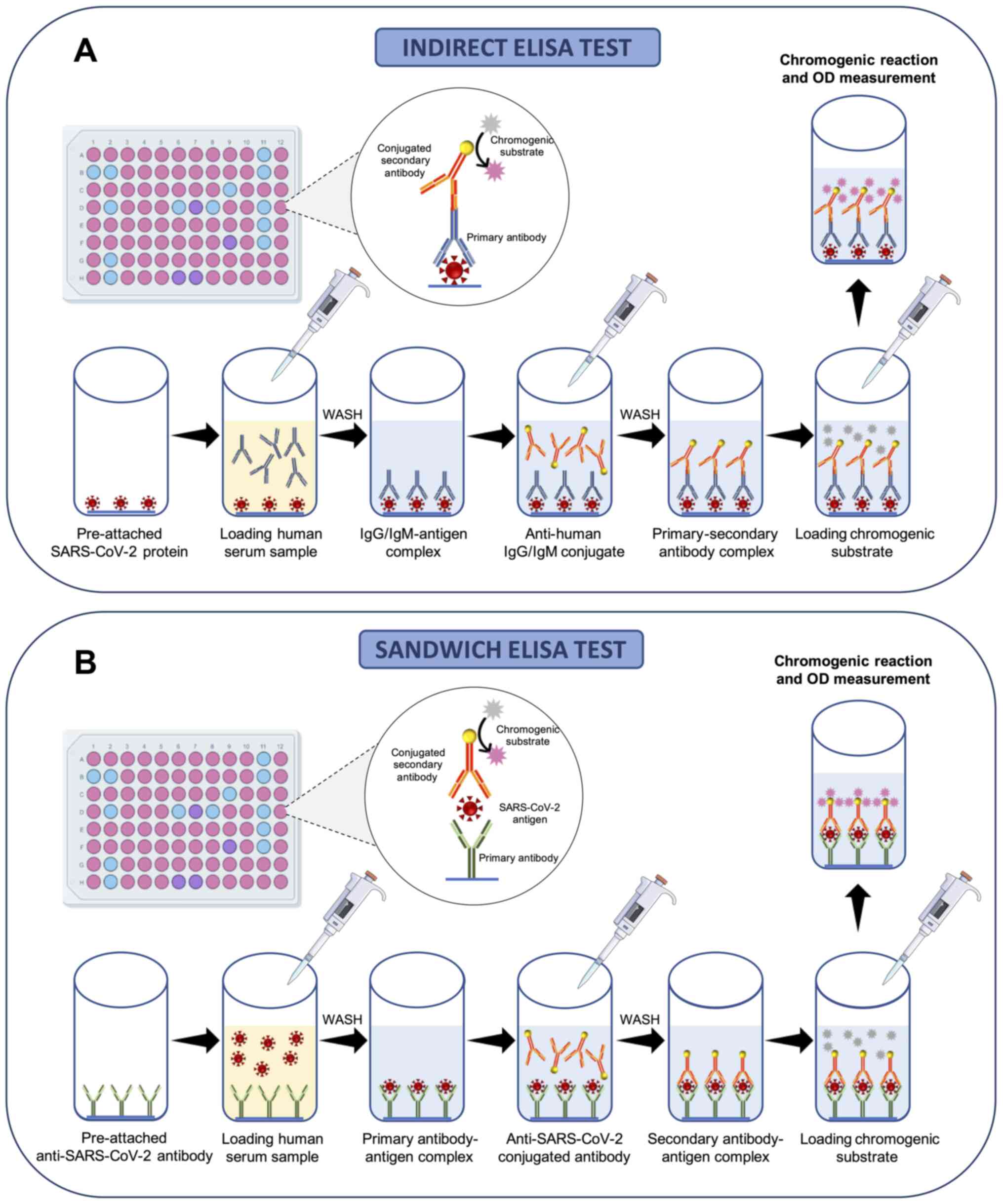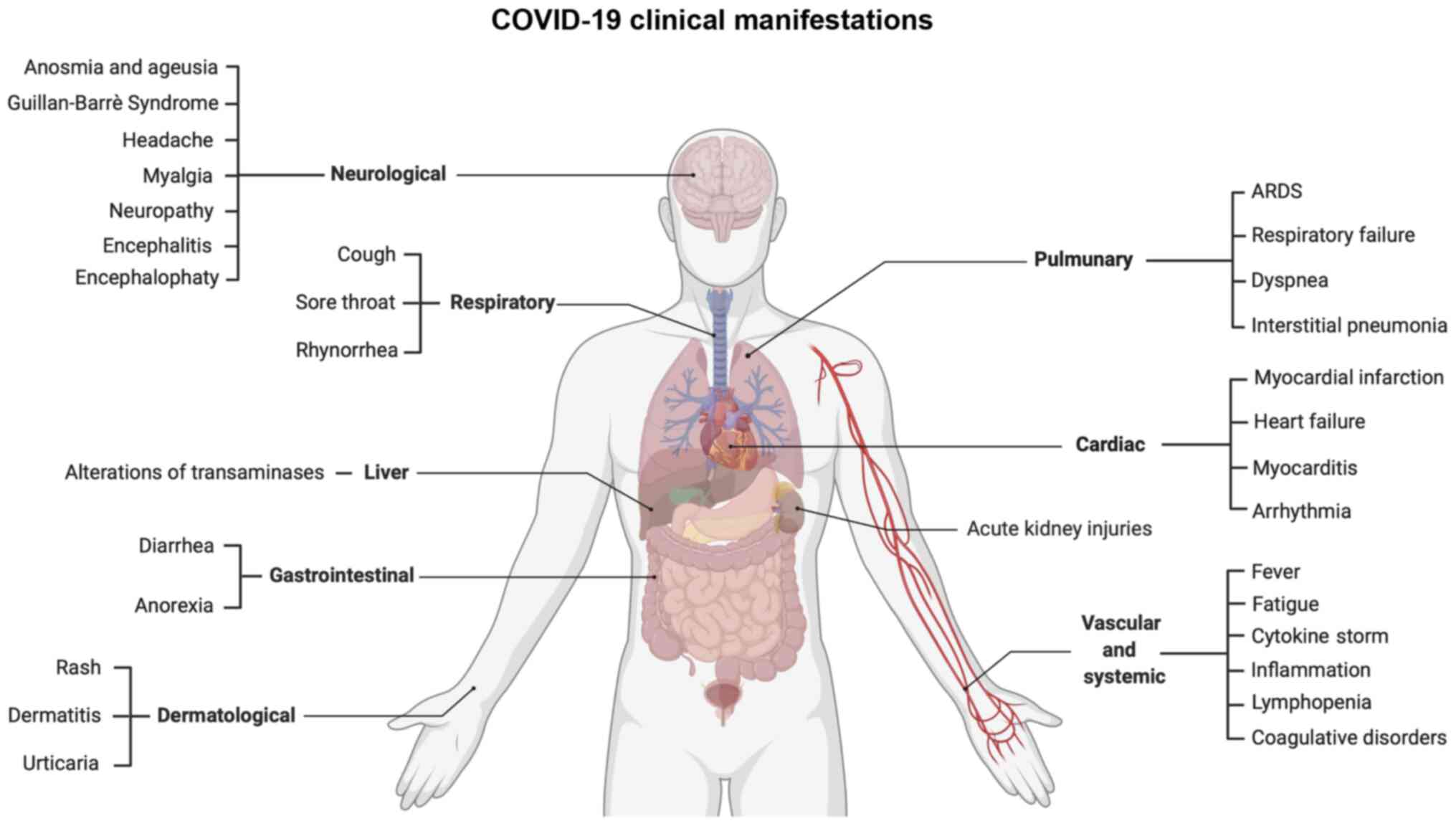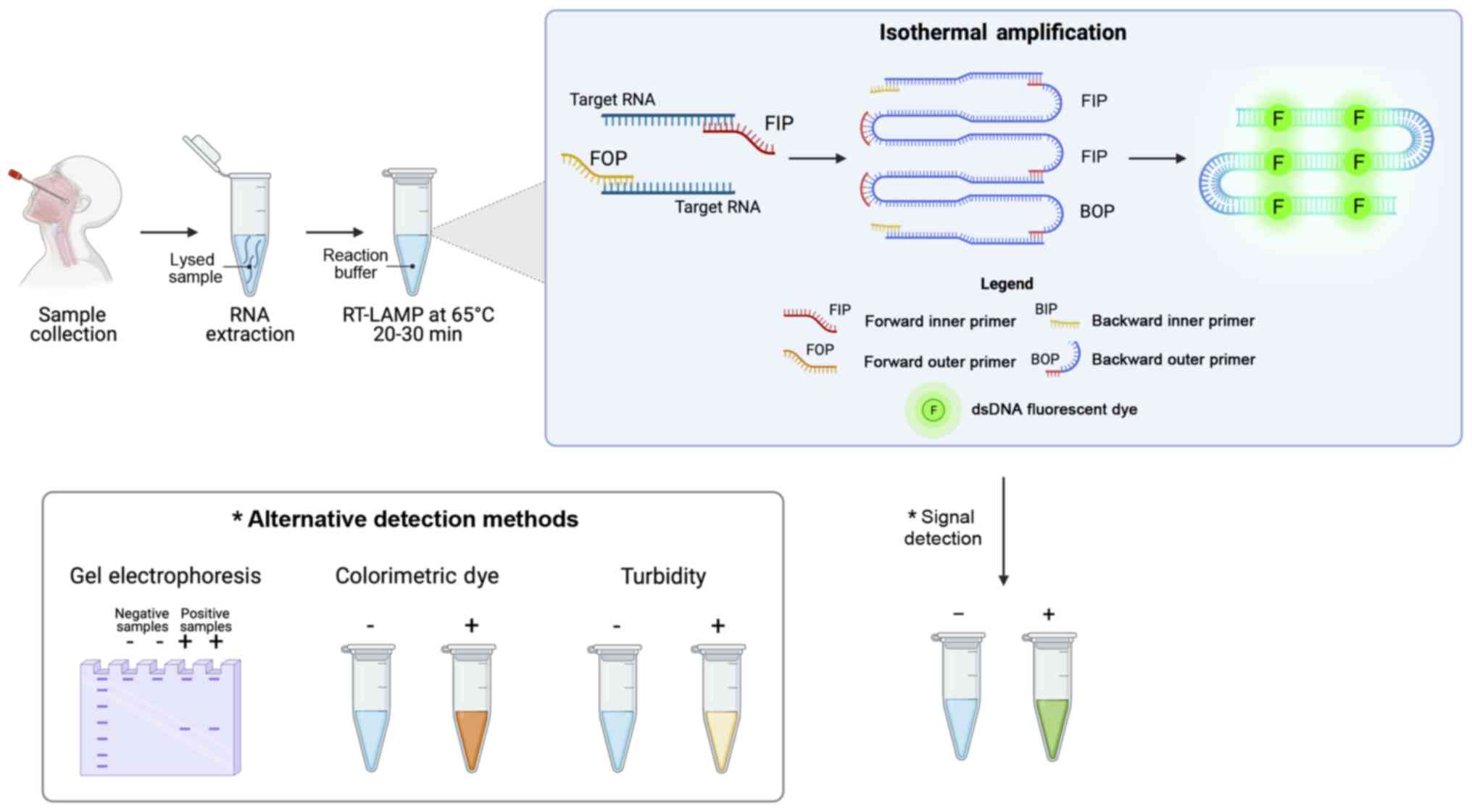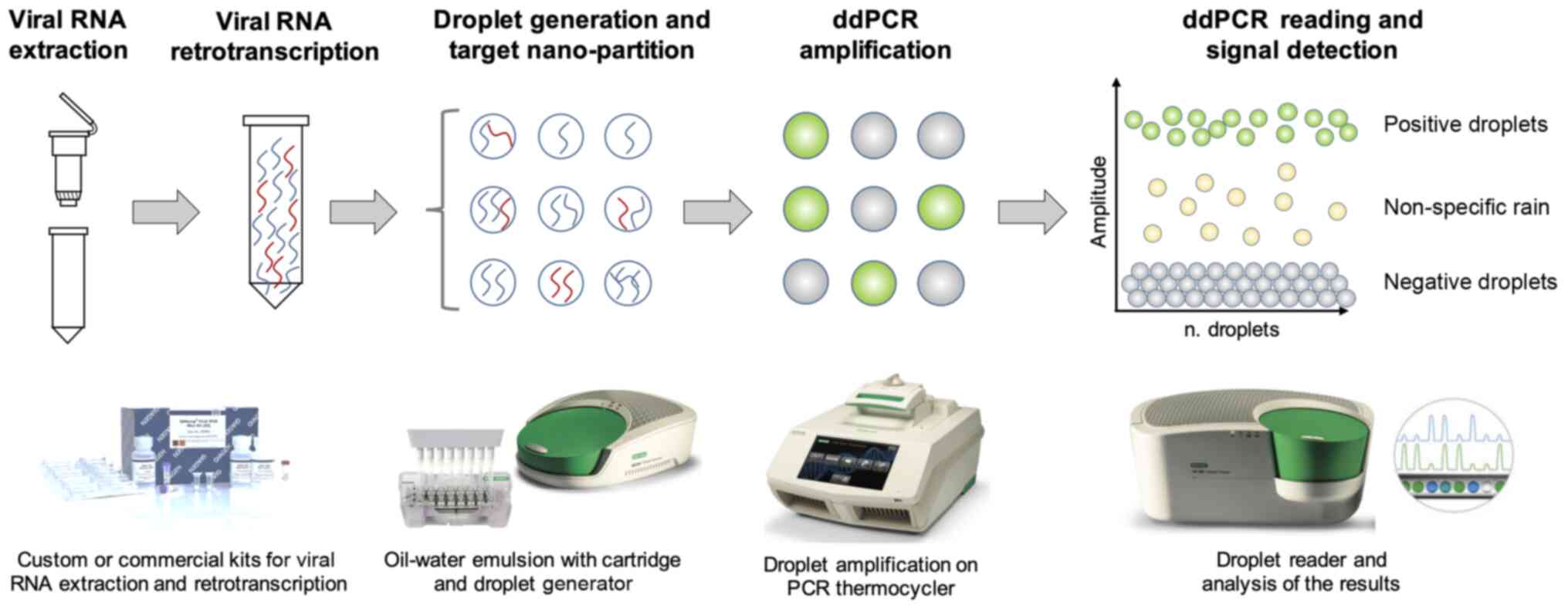|
1
|
Bontempi E: The europe second wave of
COVID-19 infection and the Italy 'strange' situation. Environ Res.
193:1104762021. View Article : Google Scholar
|
|
2
|
Cacciapaglia G, Cot C and Sannino F:
Second wave COVID-19 pandemics in Europe: A temporal playbook. Sci
Rep. 10:155142020. View Article : Google Scholar : PubMed/NCBI
|
|
3
|
COVID-19 Dashboard by the Center for
Systems Science and Engineering (CSSE) Jonhs Hopkins University
(JHU). https://gisanddata.maps.arcgis.com/apps/opsdashboard/index.html#/bda7594740fd40299423467b48e9ecf6.
Accessed February 27, 2021.
|
|
4
|
Polack FP, Thomas SJ, Kitchin N, Absalon
J, Gurtman A, Lockhart S, Perez JL, Pérez Marc G, Moreira ED,
Zerbini C; C4591001 Clinical Trial Group; et al: Safety and
Efficacy of the BNT162b2 mRNA Covid-19 Vaccine. N Engl J Med.
383:2603–2615. 2020. View Article : Google Scholar : PubMed/NCBI
|
|
5
|
European Medicine Agency (EMA): COVID-19
Vaccines. https://www.ema.europa.eu/en/human-regulatory/overview/public-health-threats/coronavirus-disease-covid-19/treatments-vaccines/covid-19-vaccines.
Accessed February 27, 2021.
|
|
6
|
Dong E, Du H and Gardner L: An interactive
web-based dashboard to track COVID-19 in real time. Lancet Infect
Dis. 20:533–534. 2020. View Article : Google Scholar : PubMed/NCBI
|
|
7
|
Pullano G, Di Domenico L, Sabbatini CE,
Valdano E, Turbelin C, Debin M, Guerrisi C, Kengne-Kuetche C, Souty
C, Hanslik T, et al: Underdetection of cases of COVID-19 in France
threatens epidemic control. Nature. 590:134–139. 2021. View Article : Google Scholar
|
|
8
|
O'Dowd A: Covid-19: Avoid indoor mixing
over Christmas or risk third wave, warns iSAGE. BMJ. 371:m48322020.
View Article : Google Scholar : PubMed/NCBI
|
|
9
|
Farsalinos K, Poulas K, Kouretas D,
Vantarakis A, Leotsinidis M, Kouvelas D, Docea AO, Kostoff R,
Gerotziafas GT, Antoniou MN, et al: Improved strategies to counter
the COVID-19 pandemic: Lockdowns vs. primary and community
healthcare. Toxicol Rep. 8:1–9. 2021. View Article : Google Scholar
|
|
10
|
Liu S and Pan C: Differentiating diagnosis
of COVID-19 or influenza in patients based on laboratory data
during flu season. EClinicalMedicine. 26:1005112020. View Article : Google Scholar : PubMed/NCBI
|
|
11
|
García-Basteiro AL, Chaccour C, Guinovart
C, Llupià A, Brew J, Trilla A and Plasencia A: Monitoring the
COVID-19 epidemic in the context of widespread local transmission.
Lancet Respir Med. 8:440–442. 2020. View Article : Google Scholar : PubMed/NCBI
|
|
12
|
Wu AHB: Screening the General Population
for SARS-CoV-2 Virus and COVID-19 Antibodies: A Counterargument. J
Appl Lab Med. 5:1107–1110. 2020. View Article : Google Scholar : PubMed/NCBI
|
|
13
|
Rostami A, Sepidarkish M, Leeflang MMG,
Riahi SM, Nourollahpour Shiadeh M, Esfandyari S, Mokdad AH, Hotez
PJ and Gasser RB: SARS-CoV-2 seroprevalence worldwide: a systematic
review and meta-analysis. Clin Microbiol Infect. 27:331–340. 2021.
View Article : Google Scholar
|
|
14
|
Wells PM, Doores KJ, Couvreur S, Nunez RM,
Seow J, Graham C, Acors S, Kouphou N, Neil SJD, Tedder RS, et al:
Estimates of the rate of infection and asymptomatic COVID-19
disease in a population sample from SE England. J Infect.
81:931–936. 2020. View Article : Google Scholar : PubMed/NCBI
|
|
15
|
Ji T, Liu Z, Wang G, Guo X, Akbar Khan S,
Lai C, Chen H, Huang S, Xia S, Chen B, et al: Detection of
COVID-19: A review of the current literature and future
perspectives. Biosens Bioelectron. 166:1124552020. View Article : Google Scholar : PubMed/NCBI
|
|
16
|
Sanyaolu A, Okorie C, Marinkovic A,
Ayodele O, Abbasi AF, Prakash S, Ahmed M, Kayode D, Jaferi U and
Haider N: Navigating the diagnostics of COVID-19. SN Compr Clin
Med. Jul 25–2020.Epub ahead of print. View Article : Google Scholar : PubMed/NCBI
|
|
17
|
European Commission (EC): Current
performance of COVID-19 test methods and devices and proposed
performance criteria. EC; Brussels: 2020, https://ec.europa.eu/docsroom/documents/40805.
Accessed January 2, 2021.
|
|
18
|
Taleghani N and Taghipour F: Diagnosis of
COVID-19 for controlling the pandemic: A review of the
state-of-the-art. Biosens Bioelectron. 174:1128302021. View Article : Google Scholar
|
|
19
|
Jung J, Jang H, Kim HK, Kim J, Kim A and
Ko KP: The Importance of Mandatory COVID-19 Diagnostic Testing
Prior to Release from Quarantine. J Korean Med Sci. 35:e3142020.
View Article : Google Scholar : PubMed/NCBI
|
|
20
|
Winter AK and Hegde ST: The important role
of serology for COVID-19 control. Lancet Infect Dis. 20:758–759.
2020. View Article : Google Scholar : PubMed/NCBI
|
|
21
|
Vandenberg O, Martiny D, Rochas O, van
Belkum A and Kozlakidis Z: Considerations for diagnostic COVID-19
tests. Nat Rev Microbiol. 19:171–183. 2021. View Article : Google Scholar
|
|
22
|
Tromberg BJ, Schwetz TA, Pérez-Stable EJ,
Hodes RJ, Woychik RP, Bright RA, Fleurence RL and Collins FS: Rapid
scaling up of Covid-19 diagnostic testing in the United States -
The NIH RADx Initiative. N Engl J Med. 383:1071–1077. 2020.
View Article : Google Scholar : PubMed/NCBI
|
|
23
|
Guglielmi G: The explosion of new
coronavirus tests that could help to end the pandemic. Nature.
583:506–509. 2020. View Article : Google Scholar : PubMed/NCBI
|
|
24
|
Tsatsakis A, Calina D, Falzone L, Petrakis
D, Mitrut R, Siokas V, Pennisi M, Lanza G, Libra M, Doukas SG, et
al: SARS-CoV-2 pathophysiology and its clinical implications: An
integrative overview of the pharmacotherapeutic management of
COVID-19. Food Chem Toxicol. 146:1117692020. View Article : Google Scholar : PubMed/NCBI
|
|
25
|
Alpdagtas S, Ilhan E, Uysal E, Sengor M,
Ustundag CB and Gunduz O: Evaluation of current diagnostic methods
for COVID-19. APL Bioeng. 4:0415062020. View Article : Google Scholar : PubMed/NCBI
|
|
26
|
Wu F, Zhao S, Yu B, Chen YM, Wang W, Song
ZG, Hu Y, Tao ZW, Tian JH, Pei YY, et al: A new coronavirus
associated with human respiratory disease in China. Nature.
579:265–269. 2020. View Article : Google Scholar : PubMed/NCBI
Erratum. Nature. 580:E72020.
|
|
27
|
Zhu N, Zhang D, Wang W, Li X, Yang B, Song
J, Zhao X, Huang B, Shi W, Lu R, et al: China novel coronavirus
investigating and research team: a novel coronavirus from patients
with pneumonia in China 2019. N Engl J Med. 382:727–733. 2020.
View Article : Google Scholar : PubMed/NCBI
|
|
28
|
Kumar R, Nagpal S, Kaushik S and
Mendiratta S: COVID-19 diagnostic approaches: Different roads to
the same destination. Virusdisease. 31:97–105. 2020. View Article : Google Scholar : PubMed/NCBI
|
|
29
|
Brun AL, Gence-Breney A, Trichereau J,
Ballester MC, Vasse M, Chabi ML, Mellot F and Grenier PA: COVID-19
pneumonia: High diagnostic accuracy of chest CT in patients with
intermediate clinical probability. Eur Radiol. 31:1969–1977. 2021.
View Article : Google Scholar
|
|
30
|
Martinez RM: Clinical samples for
SARS-CoV-2 detection: Review of the early literature. Clin
Microbiol Newsl. 42:121–127. 2020. View Article : Google Scholar : PubMed/NCBI
|
|
31
|
Rao GG, Agarwal A and Batura D: Testing
times in Coronavirus disease (COVID-19): A tale of two nations. Med
J Armed Forces India. 76:243–249. 2020. View Article : Google Scholar : PubMed/NCBI
|
|
32
|
Jarvis KF and Kelley JB: Temporal dynamics
of viral load and false negative rate influence the levels of
testing necessary to combat COVID19 spread. medRxiv. View Article : Google Scholar
|
|
33
|
Rode OĐ, Kurolt IC, Puljiz I, Čivljak R,
Balent NC, Laškaj R, Tiljak MK, Mikulić R and Markotić A: Antibody
response and the clinical presentation of patients with COVID-19 in
Croatia: The importance of a two-step testing approach. Eur J Clin
Microbiol Infect Dis. 40:261–268. 2021. View Article : Google Scholar
|
|
34
|
Bisoffi Z, Pomari E, Deiana M, Piubelli C,
Ronzoni N, Beltrame A, Bertoli G, Riccardi N, Perandin F, Formenti
F, et al: Sensitivity, specificity and predictive values of
molecular and serological tests for COVID-19: a longitudinal study
in emergency room. Diagnostics (Basel). 10:6692020. View Article : Google Scholar
|
|
35
|
Krajewski R, Gołębiowska J, Makuch S,
Mazur G and Agrawal S: Update on serologic testing in COVID-19.
Clin Chim Acta. 510:746–750. 2020. View Article : Google Scholar : PubMed/NCBI
|
|
36
|
Guo L, Ren L, Yang S, Xiao M, Chang D,
Yang F, Dela Cruz CS, Wang Y, Wu C, Xiao Y, et al: Profiling early
humoral response to diagnose novel coronavirus disease (COVID-19).
Clin Infect Dis. 71:778–785. 2020. View Article : Google Scholar : PubMed/NCBI
|
|
37
|
Chirumbolo S: Swabbing Thoroughly People
for COVID-19 Positivity. Insights on the Main Bio-analytical and
Microbiology Bias and Concerns. Curr Microbiol. 77:3680–3684. 2020.
View Article : Google Scholar : PubMed/NCBI
|
|
38
|
Lippi G, Simundic AM and Plebani M:
Potential preanalytical and analytical vulnerabilities in the
laboratory diagnosis of coronavirus disease 2019 (COVID-19). Clin
Chem Lab Med. 58:1070–1076. 2020. View Article : Google Scholar : PubMed/NCBI
|
|
39
|
Ora J, Puxeddu E, Cavalli F, Giorgino FM,
Girolami A, Chiocchi M, Sergiacomi G, Federici M and Rogliani P:
Does bronchoscopy help the diagnosis in COVID-19 infection? Eur
Respir J. 56:20016192020. View Article : Google Scholar : PubMed/NCBI
|
|
40
|
Tong Y, Bao A, Chen H, Huang J, Lv Z, Feng
L, Cheng Y, Wang Y, Bai L, Rao W, et al: Necessity for detection of
SARS-CoV-2 RNA in multiple types of specimens for the discharge of
the patients with COVID-19. J Transl Med. 18:4112020. View Article : Google Scholar : PubMed/NCBI
|
|
41
|
McFee DRB: COVID-19 Laboratory Testing/CDC
Guidelines. Dis Mon. 66:1010672020. View Article : Google Scholar : PubMed/NCBI
|
|
42
|
Fu Y, Li Y, Guo E, He L, Liu J, Yang B, Li
F, Wang Z, Li Y, Xiao R, et al: Dynamics and correlation among
viral positivity, seroconversion, and disease severity in COVID-19:
a retrospective study. Ann Intern Med. 8:M20–M3337. 2020.
|
|
43
|
Mesoraca A, Margiotti K, Viola A, Cima A,
Sparacino D and Giorlandino C: Evaluation of SARS-CoV-2 viral RNA
in fecal samples. Virol J. 17:862020. View Article : Google Scholar : PubMed/NCBI
|
|
44
|
Ng SC and Tilg H: COVID-19 and the
gastrointestinal tract: More than meets the eye. Gut. 69:973–974.
2020. View Article : Google Scholar : PubMed/NCBI
|
|
45
|
Long DR, Gombar S, Hogan CA, Greninger AL,
O'Reilly-Shah V, Bryson-Cahn C, Stevens B, Rustagi A, Jerome KR,
Kong CS, et al: Occurrence and timing of subsequent severe acute
respiratory syndrome coronavirus 2 reverse-transcription polymerase
chain reaction positivity among initially negative patients. Clin
Infect Dis. 72:323–326. 2021. View Article : Google Scholar : PubMed/NCBI
|
|
46
|
Mahendiratta S, Batra G, Sarma P, Kumar H,
Bansal S, Kumar S, Prakash A, Sehgal R and Medhi B: Molecular
diagnosis of COVID-19 in different biologic matrix, their
diagnostic validity and clinical relevance: A systematic review.
Life Sci. 258:1182072020. View Article : Google Scholar : PubMed/NCBI
|
|
47
|
da Silva SJR, Silva CTAD, Guarines KM,
Mendes RPG, Pardee K, Kohl A and Pena L: Clinical and Laboratory
Diagnosis of SARS-CoV-2, the Virus Causing COVID-19. ACS Infect
Dis. 6:2319–2336. 2020. View Article : Google Scholar : PubMed/NCBI
|
|
48
|
Li D, Zhang J and Li J: Primer design for
quantitative real-time PCR for the emerging Coronavirus SARS-CoV-2.
Theranostics. 10:7150–7162. 2020. View Article : Google Scholar : PubMed/NCBI
|
|
49
|
Chan JF, Kok KH, Zhu Z, Chu H, To KK, Yuan
S and Yuen KY: Genomic characterization of the 2019 novel
human-pathogenic coronavirus isolated from a patient with atypical
pneumonia after visiting Wuhan. Emerg Microbes Infect. 9:221–236.
2020. View Article : Google Scholar : PubMed/NCBI
|
|
50
|
Centers for Disease Control and Prevention
(CDC): CDC's Diagnostic Test for COVID-19 Only and Supplies.
https://www.cdc.gov/coronavirus/2019-ncov/lab/virus-requests.html.
Accessed January 5, 2021.
|
|
51
|
Centers for Disease Control and Prevention
(CDC): Research Use Only 2019-Novel Coronavirus (2019-nCoV)
Real-time RT-PCR Primers and Probes. https://www.cdc.gov/coronavirus/2019-ncov/lab/rt-pcr-panel-primer-probes.html.
Accessed January 5, 2021.
|
|
52
|
Dorlass EG, Monteiro CO, Viana AO, Soares
CP, Machado RRG, Thomazelli LM, Araujo DB, Leal FB, Candido ED,
Telezynski BL, et al: Lower cost alternatives for molecular
diagnosis of COVID-19: Conventional RT-PCR and SYBR Green-based
RT-qPCR. Braz J Microbiol. 51:1117–1123. 2020. View Article : Google Scholar : PubMed/NCBI
|
|
53
|
Neilan AM, Losina E, Bangs AC, Flanagan C,
Panella C, Eskibozkurt GE, Mohareb A, Hyle EP, Scott JA, Weinstein
MC, et al: Clinical Impact, Costs, and Cost-Effectiveness of
Expanded SARS-CoV-2 Testing in Massachusetts. Clin Infect Dis. Sep
18–2020.Epub ahead of print. View Article : Google Scholar
|
|
54
|
Smyrlaki I, Ekman M, Lentini A, Rufino de
Sousa N, Papanicolaou N, Vondracek M, Aarum J, Safari H,
Muradrasoli S, Rothfuchs AG, et al: Massive and rapid COVID-19
testing is feasible by extraction-free SARS-CoV-2 RT-PCR. Nat
Commun. 11:48122020. View Article : Google Scholar : PubMed/NCBI
|
|
55
|
U.S Food & Drug: COVID-19 tests and
collection kits authorized by the FDA in 2020: Infographic.
https://www.fda.gov/medical-devices/coronavirus-covid-19-and-medical-devices/covid-19-tests-and-collection-kits-authorized-fda-2020-infographic.
Accessed January 8, 2021.
|
|
56
|
Fomsgaard AS and Rosenstierne MW: An
alternative workflow for molecular detection of SARS-CoV-2 - escape
from the NA extraction kit-shortage, Copenhagen, Denmark, March
2020. Euro Surveill. 25:20003982020. View Article : Google Scholar
|
|
57
|
Udugama B, Kadhiresan P, Kozlowski HN,
Malekjahani A, Osborne M, Li VYC, Chen H, Mubareka S, Gubbay JB and
Chan WCW: Diagnosing COVID-19: The Disease and Tools for Detection.
ACS Nano. 14:3822–3835. 2020. View Article : Google Scholar : PubMed/NCBI
|
|
58
|
Ravi N, Cortade DL, Ng E and Wang SX:
Diagnostics for SARS-CoV-2 detection: A comprehensive review of the
FDA-EUA COVID-19 testing landscape. Biosens Bioelectron.
165:1124542020. View Article : Google Scholar : PubMed/NCBI
|
|
59
|
Wells CR, Townsend JP, Pandey A, Moghadas
SM, Krieger G, Singer B, McDonald RH, Fitzpatrick MC and Galvani
AP: Optimal COVID-19 quarantine and testing strategies. Nat Commun.
12:3562021. View Article : Google Scholar : PubMed/NCBI
|
|
60
|
Bustin SA and Nolan T: RT-qPCR Testing of
SARS-CoV-2: A Primer. Int J Mol Sci. 21:30042020. View Article : Google Scholar :
|
|
61
|
Böger B, Fachi MM, Vilhena RO, Cobre AF,
Tonin FS and Pontarolo R: Systematic review with meta-analysis of
the accuracy of diagnostic tests for COVID-19. Am J Infect Control.
49:21–29. 2021. View Article : Google Scholar
|
|
62
|
Kucirka LM, Lauer SA, Laeyendecker O, Boon
D and Lessler J: Variation in false-negative rate of reverse
transcriptase polymerase chain reaction-based SARS-CoV-2 tests by
time since exposure. Ann Intern Med. 173:262–267. 2020. View Article : Google Scholar : PubMed/NCBI
|
|
63
|
Afzal A: Molecular diagnostic technologies
for COVID-19: Limitations and challenges. J Adv Res. 26:149–159.
2020. View Article : Google Scholar : PubMed/NCBI
|
|
64
|
Tahamtan A and Ardebili A: Real-time
RT-PCR in COVID-19 detection: Issues affecting the results. Expert
Rev Mol Diagn. 20:453–454. 2020. View Article : Google Scholar : PubMed/NCBI
|
|
65
|
Pan Y, Long L, Zhang D, Yuan T, Cui S,
Yang P, Wang Q and Ren S: Potential false-negative nucleic acid
testing results for severe acute respiratory syndrome coronavirus 2
from thermal inactivation of samples with low viral loads. Clin
Chem. 66:794–801. 2020. View Article : Google Scholar : PubMed/NCBI
|
|
66
|
Li Y, Yao L, Li J, Chen L, Song Y, Cai Z
and Yang C: Stability issues of RT-PCR testing of SARS-CoV-2 for
hospitalized patients clinically diagnosed with COVID-19. J Med
Virol. 92:903–908. 2020. View Article : Google Scholar : PubMed/NCBI
|
|
67
|
World Health Organization (WHO):
Recommendations for laboratories testing by PCR for presence of
SARS coronavirus-RNA. WHO; Geneva: 2020, https://www.who.int/csr/sars/coronarec-ommendations/en/.
Accessed January 26, 2021.
|
|
68
|
Cerutti F, Burdino E, Milia MG, Allice T,
Gregori G, Bruzzone B and Ghisetti V: Urgent need of rapid tests
for SARS CoV-2 antigen detection: Evaluation of the SD-Biosensor
antigen test for SARS-CoV-2. J Clin Virol. 132:1046542020.
View Article : Google Scholar : PubMed/NCBI
|
|
69
|
Olalekan A, Iwalokun B, Akinloye OM,
Popoola O, Samuel TA and Akinloye O: COVID-19 rapid diagnostic test
could contain transmission in low- and middle-income countries. Afr
J Lab Med. 9:12552020. View Article : Google Scholar : PubMed/NCBI
|
|
70
|
Augustine R, Das S, Hasan ASA, Abdul Salam
S, Augustine P, Dalvi YB, Varghese R, Primavera R, Yassine HM, et
al: Rapid antibody-based COVID-19 mass surveillance: relevance,
challenges, and prospects in a pandemic and post-pandemic world. J
Clin Med. 9:33722020. View Article : Google Scholar :
|
|
71
|
Albert E, Torres I, Bueno F, Huntley D,
Molla E, Fernández-Fuentes MÁ, Martínez M, Poujois S, Forqué L,
Valdivia A, et al: Field evaluation of a rapid antigen test
(Panbio™ COVID-19 Ag Rapid Test Device) for COVID-19 diagnosis in
primary healthcare centres. Clin Microbiol Infect.
27:472.e7–472.e10. 2021. View Article : Google Scholar
|
|
72
|
Pilarowski G, Lebel P, Sunshine S, Liu J,
Crawford E, Marquez C, Rubio L, Chamie G, Martinez J, Peng J, et
al: Performance characteristics of a rapid SARS-CoV-2 antigen
detection assay at a public plaza testing site in San Francisco. J
Infect Dis. Jan 4–2021.Epub ahead of print. View Article : Google Scholar :
|
|
73
|
Lee JH, Choi M, Jung Y, Lee SK, Lee CS,
Kim J, Kim J, Kim NH, Kim BT and Kim HG: A novel rapid detection
for SARS-CoV-2 spike 1 antigens using human angiotensin converting
enzyme 2 (ACE2). Biosens Bioelectron. 171:1127152021. View Article : Google Scholar
|
|
74
|
Diao B, Wen K, Zhang J, Chen J, Han C,
Chen Y, Wang S, Deng G, Zhou H and Wu Y: Accuracy of a nucleocapsid
protein antigen rapid test in the diagnosis of SARS-CoV-2
infection. Clin Microbiol Infect. 27:289.e1–289.e4. 2021.
View Article : Google Scholar
|
|
75
|
Carter LJ, Garner LV, Smoot JW, Li Y, Zhou
Q, Saveson CJ, Sasso JM, Gregg AC, Soares DJ, Beskid TR, et al:
Assay Techniques and Test Development for COVID-19 Diagnosis. ACS
Cent Sci. 6:591–605. 2020. View Article : Google Scholar : PubMed/NCBI
|
|
76
|
Huang C, Wen T, Shi FJ, Zeng XY and Jiao
YJ: Rapid detection of igm antibodies against the SARS-CoV-2 virus
via colloidal gold nanoparticle-based lateral-flow assay. ACS
Omega. 5:12550–12556. 2020. View Article : Google Scholar : PubMed/NCBI
|
|
77
|
Mak GC, Cheng PK, Lau SS, Wong KK, Lau CS,
Lam ET, Chan RC and Tsang DN: Evaluation of rapid antigen test for
detection of SARS-CoV-2 virus. J Clin Virol. 129:1045002020.
View Article : Google Scholar : PubMed/NCBI
|
|
78
|
Lanser L, Bellmann-Weiler R, Öttl KW,
Huber L, Griesmacher A, Theurl I and Weiss G: Evaluating the
clinical utility and sensitivity of SARS-CoV-2 antigen testing in
relation to RT-PCR Ct values. Infection. 13:1–3. 2020.
|
|
79
|
Dinnes J, Deeks JJ, Adriano A, Berhane S,
Davenport C, Dittrich S, Emperador D, Takwoingi Y, Cunningham J,
Beese S, et al: Cochrane COVID-19 Diagnostic Test Accuracy Group:
Rapid, point-of-care antigen and molecular-based tests for
diagnosis of SARS-CoV-2 infection. Cochrane Database Syst Rev.
8:CD0137052020.
|
|
80
|
Montesinos I, Gruson D, Kabamba B, Dahma
H, Van den Wijngaert S, Reza S, Carbone V, Vandenberg O, Gulbis B,
Wolff F, et al: Evaluation of two automated and three rapid lateral
flow immunoassays for the detection of anti-SARS-CoV-2 antibodies.
J Clin Virol. 128:1044132020. View Article : Google Scholar : PubMed/NCBI
|
|
81
|
Prazuck T, Colin M, Giachè S, Gubavu C,
Seve A, Rzepecki V, Chevereau-Choquet M, Kiani C, Rodot V, Lionnet
E, et al: Evaluation of performance of two SARS-CoV-2 Rapid IgM-IgG
combined antibody tests on capillary whole blood samples from the
fingertip. PLoS One. 15:e02376942020. View Article : Google Scholar : PubMed/NCBI
|
|
82
|
Jacobs J, Kühne V, Lunguya O, Affolabi D,
Hardy L and Vandenberg O: Implementing COVID-19 (SARS-CoV-2) rapid
diagnostic tests in Sub-Saharan Africa: a review. Front Med
(Lausanne). 7:5577972020. View Article : Google Scholar
|
|
83
|
La Rosa Fabián C and Urquizo Briceño L:
Anti-SARS-Cov-2 IgA in Current Scenario of IgM and IgG Rapid Test:
A New Alternative for the Diagnostic of COVID-19. SN Compr Clin
Med. 26:1–3. 2020.
|
|
84
|
Canetti D, Dell'Acqua R, Riccardi N, Della
Torre L, Bigoloni A, Muccini C, Bruzzesi E, Ranzenigo M, Chiurlo M,
Racca S, et al: SARS-CoV-2 IgG/IgM Rapid Test as a Diagnostic Tool
in Hospitalized Patients and Healthcare Workers, at a large
Teaching Hospital in northern Italy, during the 2020 COVID-19
Pandemic. New Microbiol. 43:161–165. 2020.PubMed/NCBI
|
|
85
|
Alhajj M and Farhana A: Enzyme Linked
Immunosorbent Assay. StatPearls. StatPearls Publishing; Treasure
Island, FL: 2020
|
|
86
|
Tré-Hardy M, Wilmet A, Beukinga I,
Favresse J, Dogné JM, Douxfils J and Blairon L: Analytical and
clinical validation of an ELISA for specific SARS-CoV-2 IgG, IgA,
and IgM anti-bodies. J Med Virol. 93:803–811. 2021. View Article : Google Scholar
|
|
87
|
Freeman B, Lester S, Mills L, Rasheed MAU,
Moye S, Abiona O, Hutchinson GB, Morales-Betoulle M, Krapinunaya I,
Gibbons A, et al: Validation of a SARS-CoV-2 spike protein ELISA
for use in contact investigations and serosurveillance. bioRxiv.
View Article : Google Scholar
|
|
88
|
Korth J, Wilde B, Dolff S, Anastasiou OE,
Krawczyk A, Jahn M, Cordes S, Ross B, Esser S, Lindemann M, et al:
SARS-CoV-2-specific antibody detection in healthcare workers in
Germany with direct contact to COVID-19 patients. J Clin Virol.
128:1044372020. View Article : Google Scholar : PubMed/NCBI
|
|
89
|
Alharbi SA, Almutairi AZ, Jan AA and
Alkhalify AM: Enzyme-linked immunosorbent assay for the detection
of severe acute respiratory syndrome coronavirus 2 (SARS-CoV-2)
IgM/IgA and IgG antibodies among healthcare workers. Cureus.
12:e102852020.PubMed/NCBI
|
|
90
|
Stringhini S, Wisniak A, Piumatti G, Azman
AS, Lauer SA, Baysson H, De Ridder D, Petrovic D, Schrempft S,
Marcus K, et al: Seroprevalence of anti-SARS-CoV-2 IgG antibodies
in Geneva, Switzerland (SEROCoV-POP): A population-based study.
Lancet. 396:313–319. 2020. View Article : Google Scholar : PubMed/NCBI
|
|
91
|
Vashist SK: In vitro diagnostic assays for
COVID-19: recent advances and emerging trends. Diagnostics (Basel).
10:2022020. View Article : Google Scholar
|
|
92
|
Tanaka Y, Kamimura K, Nakamura R,
Ohkoshi-Yamada M, Koseki Y, Mizusawa T, Ikarashi S, Hayashi K, Sato
H, Sakamaki A, et al: Usefulness of ultrasonography to assess the
response to steroidal therapy for the rare case of type 2b
immunoglobulin G4-related sclerosing cholangitis without
pancreatitis: A case report. World J Clin Cases. 8:5821–5830. 2020.
View Article : Google Scholar : PubMed/NCBI
|
|
93
|
AvŞar T, ÇaliŞ Ş, Yilmaz B, Demİrcİ
OtluoĞlu G, Holyavkİn C and Kili CT: Genome-wide identification of
Chiari malformation type I associated candidate genes and
chromosomal variations. Turk J Biol. 44:449–456. 2020. View Article : Google Scholar
|
|
94
|
La Marca A, Capuzzo M, Paglia T, Roli L,
Trenti T and Nelson SM: Testing for SARS-CoV-2 (COVID-19): A
systematic review and clinical guide to molecular and serological
in-vitro diagnostic assays. Reprod Biomed Online. 41:483–499. 2020.
View Article : Google Scholar : PubMed/NCBI
|
|
95
|
Sheikhzadeh E, Eissa S, Ismail A and
Zourob M: Diagnostic techniques for COVID-19 and new developments.
Talanta. 220:1213922020. View Article : Google Scholar : PubMed/NCBI
|
|
96
|
Zhu N, Wang W, Liu Z, Liang C, Wang W, Ye
F, Huang B, Zhao L, Wang H, Zhou W, et al: Morphogenesis and
cytopathic effect of SARS-CoV-2 infection in human airway
epithelial cells. Nat Commun. 11:39102020. View Article : Google Scholar : PubMed/NCBI
|
|
97
|
Leland DS and Ginocchio CC: Role of cell
culture for virus detection in the age of technology. Clin
Microbiol Rev. 20:49–78. 2007. View Article : Google Scholar : PubMed/NCBI
|
|
98
|
Jain R, Sarkale P, Mali D, Shete AM, Patil
DY, Majumdar T, Suryawanshi A, Patil S, Mohandas S and Yadav PD:
Inactivation of SARS-CoV-2 by gamma irradiation. Indian J Med Res.
Nov 27–2020.Epub ahead of print. PubMed/NCBI
|
|
99
|
Park WB, Kwon NJ, Choi SJ, Kang CK, Choe
PG, Kim JY, Yun J, Lee GW, Seong MW, Kim NJ, et al: Virus Isolation
from the First Patient with SARS-CoV-2 in Korea. J Korean Med Sci.
35:e842020. View Article : Google Scholar : PubMed/NCBI
|
|
100
|
Zhao J, Zhou H, Huang W, Zhou J, Qiu M,
Deng Z, Chen L, Weng Y, Cai L, Gu Y, et al: Cell morphological
analysis of SARS-CoV-2 infection by transmission electron
microscopy. J Thorac Dis. 12:4368–4373. 2020. View Article : Google Scholar : PubMed/NCBI
|
|
101
|
Akilesh S, Nicosia RF, Alpers CE,
Tretiakova M, Hsiang TY, Gale M Jr and Smith KD: Characterizing
viral infection by electron microscopy: lessons from the
coronavirus disease 2019 pandemic. Am J Pathol. 191:222–227. 2021.
View Article : Google Scholar
|
|
102
|
Goldsmith CS, Tatti KM, Ksiazek TG, Rollin
PE, Comer JA, Lee WW, Rota PA, Bankamp B, Bellini WJ and Zaki SR:
Ultrastructural characterization of SARS coronavirus. Emerg Infect
Dis. 10:320–326. 2004. View Article : Google Scholar : PubMed/NCBI
|
|
103
|
Bain W, Lee JS, Watson AM and
Stitt-Fischer MS: Practical guidelines for collection, manipulation
and inactivation of SARS-CoV-2 and COVID-19 clinical specimens.
Curr Protoc Cytom. 93:e772020.PubMed/NCBI
|
|
104
|
Wu SY, Yau HS, Yu MY, Tsang HF, Chan LWC,
Cho WCS, Shing Yu AC, Yuen Yim AK, Li MJW, Wong YKE, et al: The
diagnostic methods in the COVID-19 pandemic, today and in the
future. Expert Rev Mol Diagn. 20:985–993. 2020. View Article : Google Scholar : PubMed/NCBI
|
|
105
|
Chan JF, Yuan S, Kok KH, To KK, Chu H,
Yang J, Xing F, Liu J, Yip CC, Poon RW, et al: A familial cluster
of pneumonia associated with the 2019 novel coronavirus indicating
person-to-person transmission: A study of a family cluster. Lancet.
395:514–523. 2020. View Article : Google Scholar : PubMed/NCBI
|
|
106
|
Wang M, Fu A, Hu B, Tong Y, Liu R, Liu Z,
Gu J, Xiang B, Liu J, Jiang W, et al: Nanopore targeted sequencing
for the accurate and comprehensive detection of SARS-CoV-2 and
other respiratory viruses. Small. 16:e20021692020. View Article : Google Scholar : PubMed/NCBI
|
|
107
|
Addetia A, Xie H, Roychoudhury P, Shrestha
L, Loprieno M, Huang ML, Jerome KR and Greninger AL: Identification
of multiple large deletions in ORF7a resulting in in-frame gene
fusions in clinical SARS-CoV-2 isolates. J Clin Virol.
129:1045232020. View Article : Google Scholar : PubMed/NCBI
|
|
108
|
Di Giallonardo F, Duchene S, Puglia I,
Curini V, Profeta F, Cammà C, Marcacci M, Calistri P, Holmes EC and
Lorusso A: Genomic Epidemiology of the First Wave of SARS-CoV-2 in
Italy. Viruses. 12:14382020. View Article : Google Scholar :
|
|
109
|
Moore SC, Penrice-Randal R, Alruwaili M,
Randle N, Armstrong S, Hartley C, Haldenby S, Dong X, Alrezaihi A,
Almsaud M, et al: Amplicon-Based Detection and Sequencing of
SARS-CoV-2 in Nasopharyngeal Swabs from Patients With COVID-19 and
Identification of Deletions in the Viral Genome That Encode
Proteins Involved in Interferon Antagonism. Viruses. 12:11642020.
View Article : Google Scholar :
|
|
110
|
Kames J, Holcomb DD, Kimchi O, DiCuccio M,
Hamasaki-Katagiri N, Wang T, Komar AA, Alexaki A and Kimchi-Sarfaty
C: Sequence analysis of SARS-CoV-2 genome reveals features
important for vaccine design. Sci Rep. 10:156432020. View Article : Google Scholar : PubMed/NCBI
|
|
111
|
Conti P, Caraffa A, Gallenga CE, Kritas
SK, Frydas I, Younes A, Di Emidio P, Tetè G, Pregliasco F and
Ronconi G: The British variant of the new coronavirus-19
(Sars-Cov-2) should not create a vaccine problem. J Biol Regul
Homeost Agents. 35:1–4. 2021.
|
|
112
|
Hourdel V, Kwasiborski A, Balière C,
Matheus S, Batéjat CF, Manuguerra JC, Vanhomwegen J and Caro V:
rapid genomic characterization of SARS-CoV-2 by direct
amplicon-based sequencing through comparison of MinION and Illumina
iSeq100TM system. Front Microbiol. 11:5713282020. View Article : Google Scholar :
|
|
113
|
illumina: Comprehensive Workf low for
Detecting Coronavirus Using Illumina Benchtop Systems - A Shotgun
Metagenomics Sequencing Workflow for Effective Detection and
Characterization of Coronavirus Strains. https://www.illumina.com/content/dam/illumina-marketing/documents/products/appnotes/ngs-coronavirus-app-note-1270-2020-001.pdf.
Accessed January 20, 2021.
|
|
114
|
Oxford Nanopore Technologies MinION -
Powerful, real-time, long-read sequencing in the palm of your hand.
https://nanoporetech.com/sites/default/files/s3/literature/MinION-Mk1C-brochure.pdf.
Accessed January 20, 2021.
|
|
115
|
Meredith LW, Hamilton WL, Warne B,
Houldcroft CJ, Hosmillo M, Jahun AS, Curran MD, Parmar S, Caller
LG, Caddy SL, et al: Rapid implementation of SARS-CoV-2 sequencing
to investigate cases of health-care associated COVID-19: A
prospective genomic surveillance study. Lancet Infect Dis.
20:1263–1271. 2020. View Article : Google Scholar : PubMed/NCBI
|
|
116
|
Wen F, Yu H, Guo J, Li Y, Luo K and Huang
S: Identification of the hyper-variable genomic hotspot for the
novel coronavirus SARS-CoV-2. J Infect. 80:671–693. 2020.
View Article : Google Scholar : PubMed/NCBI
|
|
117
|
Lam TT: Tracking the Genomic Footprints of
SARS-CoV-2 Transmission. Trends Genet. 36:544–546. 2020. View Article : Google Scholar : PubMed/NCBI
|
|
118
|
Landete P, Quezada Loaiza CA,
Aldave-Orzaiz B, Muñiz SH, Maldonado A, Zamora E, Sam Cerna AC, Del
Cerro E, Alonso RC and Couñago F: Clinical features and
radiological manifestations of COVID-19 disease. World J Radiol.
12:247–260. 2020. View Article : Google Scholar : PubMed/NCBI
|
|
119
|
Chen H, Ai L, Lu H and Li H: Clinical and
imaging features of COVID-19. Radiol Infect Dis. 7:43–50. 2020.
View Article : Google Scholar : PubMed/NCBI
|
|
120
|
Al-Qahtani M, AlAli S, AbdulRahman A,
Salman Alsayyad A, Otoom S and Atkin SL: The prevalence of
asymptomatic and symptomatic COVID-19 in a cohort of quarantined
subjects. Int J Infect Dis. 102:285–288. 2021. View Article : Google Scholar
|
|
121
|
Yanes-Lane M, Winters N, Fregonese F,
Bastos M, Perlman-Arrow S, Campbell JR and Menzies D: Proportion of
asymptomatic infection among COVID-19 positive persons and their
transmission potential: A systematic review and meta-analysis. PLoS
One. 15:e02415362020. View Article : Google Scholar : PubMed/NCBI
|
|
122
|
Katopodis P, Kerslake R, Davies J, Randeva
HS, Chatha K, Hall M, Spandidos DA, Anikin V, Polychronis A,
Robertus JL, et al: COVID 19 and SARS CoV 2 host cell entry
mediators: Expression profiling of TMRSS4 in health and disease.
Int J Mol Med. 47:642021. View Article : Google Scholar
|
|
123
|
Vivarelli S, Falzone L, Torino F,
Scandurra G, Russo G, Bordonaro R, Pappalardo F, Spandidos DA,
Raciti G and Libra M: Immune-checkpoint inhibitors from cancer to
COVID-19: A promising avenue for the treatment of patients with
COVID-19 (Review). Int J Oncol. 58:145–157. 2021. View Article : Google Scholar : PubMed/NCBI
|
|
124
|
Vivarelli S, Falzone L, Grillo CM,
Scandurra G, Torino F and Libra M: Cancer Management during
COVID-19 Pandemic: Is Immune Checkpoint Inhibitors-Based
Immunotherapy Harmful or Beneficial? Cancers (Basel). 12:22372020.
View Article : Google Scholar
|
|
125
|
Abdi A, Jalilian M, Sarbarzeh PA and
Vlaisavljevic Z: Diabetes and COVID-19: A systematic review on the
current evidences. Diabetes Res Clin Pract. 166:1083472020.
View Article : Google Scholar : PubMed/NCBI
|
|
126
|
Huang S, Wang J, Liu F, Liu J, Cao G, Yang
C, Liu W, Tu C, Zhu M and Xiong B: COVID-19 patients with
hypertension have more severe disease: A multicenter retrospective
observational study. Hyperte Res. 43:824–831. 2020. View Article : Google Scholar
|
|
127
|
Pascarella G, Strumia A, Piliego C, Bruno
F, Del Buono R, Costa F, Scarlata S and Agrò FE: COVID-19 diagnosis
and management: A comprehensive review. J Intern Med. 288:192–206.
2020. View Article : Google Scholar : PubMed/NCBI
|
|
128
|
Torre La G, Massetti AP, Antonelli G,
Fimiani C, Fantini M, Marte M, Faticoni A, Previte CM, Turriziani
O, Pugliese F, et al: Covid-Sapienza Collaborative Group: Anosmia
and Ageusia as Predictive Signs of COVID-19 in Healthcare Workers
in Italy: A Prospective Case-Control Study. J Clin Med. 9:28702020.
View Article : Google Scholar
|
|
129
|
Tanasa IA, Manciuc C, Carauleanu A,
Navolan DB, Bohiltea RE and Nemescu D: Anosmia and ageusia
associated with coronavirus infection (COVID-19) - what is known?
Exp Ther Med. 20:2344–2347. 2020.PubMed/NCBI
|
|
130
|
Pennisi M, Lanza G, Falzone L, Fisicaro F,
Ferri R and Bella R: SARS-CoV-2 and the Nervous System: From
Clinical Features to Molecular Mechanisms. Int J Mol Sci.
21:54752020. View Article : Google Scholar :
|
|
131
|
Connors JM and Levy JH: COVID-19 and its
implications for thrombosis and anticoagulation. Blood.
135:2033–2040. 2020. View Article : Google Scholar : PubMed/NCBI
|
|
132
|
Diao B, Wang C, Tan Y, Chen X, Liu Y, Ning
L, Chen L, Li M, Liu Y, Wang G, et al: Reduction and functional
exhaustion of T cells in patients with coronavirus disease 2019
(COVID-19). Front Immunol. 11:8272020. View Article : Google Scholar : PubMed/NCBI
|
|
133
|
Basu-Ray I, Almaddah Nk, Adeboye A and
Soos MP: Cardiac Manifestations Of Coronavirus. StatPearls.
StatPearls Publishing; Treasure Island, FL: 2020
|
|
134
|
Garland V, Kumar AB and Borum ML:
Gastrointestinal and hepatic manifestations of COVID-19: evolving
recognition and need for increased understanding in vulnerable
populations. J Natl Med Assoc. Aug 15–2020.Epub ahead of print.
|
|
135
|
Baj J, Karakuła-Juchnowicz H, Teresiński
G, Buszewicz G, Ciesielka M, Sitarz E, Forma A, Karakuła K, Flieger
W, Portincasa P, et al: COVID-19: Specific and non-specific
clinical manifestations and symptoms: the current state of
knowledge. J Clin Med. 9:17532020. View Article : Google Scholar :
|
|
136
|
Renu K, Prasanna PL and Valsala
Gopalakrishnan A: Coronaviruses pathogenesis, comorbidities and
multi-organ damage - A review. Life Sci. 255:1178392020. View Article : Google Scholar : PubMed/NCBI
|
|
137
|
Chang MC, Lee W, Hur J and Park D: Chest
Computed Tomography Findings in Asymptomatic Patients with
COVID-19. Respiration. 99:748–754. 2020. View Article : Google Scholar : PubMed/NCBI
|
|
138
|
Jędrusik P, Gaciong Z, Sklinda K,
Sierpiński R, Walecki J and Gujski M: Diagnostic role of chest
computed tomography in coronavirus disease 2019. Pol Arch Intern
Med. 130:520–528. 2020.
|
|
139
|
Kang EY, Staples CA, McGuinness G, Primack
SL and Müller NL: Detection and differential diagnosis of pulmonary
infections and tumors in patients with AIDS: Value of chest
radiography versus CT. AJR Am J Roentgenol. 166:15–19. 1996.
View Article : Google Scholar : PubMed/NCBI
|
|
140
|
Larici AR, Cicchetti G, Marano R, Merlino
B, Elia L, Calandriello L, Del Ciello A, Farchione A, Savino G,
Infante A, et al: Multimodality imaging of COVID-19 pneumonia: From
diagnosis to follow-up. A comprehensive review. Eur J Radiol.
131:1092172020. View Article : Google Scholar : PubMed/NCBI
|
|
141
|
Ippolito D, Maino C, Pecorelli A,
Allegranza P, Cangiotti C, Capodaglio C, Mariani I, Giandola T,
Gandola D, Bianco I, et al: Chest X-ray features of SARS-CoV-2 in
the emergency department: A multicenter experience from northern
Italian hospitals. Respir Med. 170:1060362020. View Article : Google Scholar : PubMed/NCBI
|
|
142
|
Li P, Chen L, Liu Z, Pan J, Zhou D, Wang
H, Gong H, Fu Z, Song Q, Min Q, et al: Clinical features and
short-term outcomes of elderly patients with COVID-19. Int J Infect
Dis. 97:245–250. 2020. View Article : Google Scholar : PubMed/NCBI
|
|
143
|
Cui N, Zou X and Xu L: Preliminary CT
findings of coronavirus disease 2019 (COVID-19). Clin Imaging.
65:124–132. 2020. View Article : Google Scholar : PubMed/NCBI
|
|
144
|
Kovács A, Palásti P, Veréb D, Bozsik B,
Palkó A and Kincses ZT: The sensitivity and specificity of chest CT
in the diagnosis of COVID-19. Eur Radiol. 13:1–6. 2020.
|
|
145
|
Zhao W, He L, Tang H, Xie X, Tang L and
Liu J: The Relationship Between Chest Imaging Findings and the
Viral Load of COVID-19. Front Med (Lausanne). 7:5585392020.
View Article : Google Scholar
|
|
146
|
Meng H, Xiong R, He R, Lin W, Hao B, Zhang
L, Lu Z, Shen X, Fan T, Jiang W, et al: CT imaging and clinical
course of asymptomatic cases with COVID-19 pneumonia at admission
in Wuhan, China. J Infect. 81:e33–e39. 2020. View Article : Google Scholar : PubMed/NCBI
|
|
147
|
Mehrabi S, Fontana S, Mambrin F, Nguyen
HQ, Righi E, Tacconelli E and Mansueto G: Pitfalls of computed
tomography in the coronavirus 2019 (COVID-19) era: a new
perspective on ground-glass opacities. Cureus.
12:e81512020.PubMed/NCBI
|
|
148
|
Tofighi S, Najafi S, Johnston SK and
Gholamrezanezhad A: Low-dose CT in COVID-19 outbreak: Radiation
safety, image wisely, and image gently pledge. Emerg Radiol.
27:601–605. 2020. View Article : Google Scholar : PubMed/NCBI
|
|
149
|
Qiu G, Gai Z, Tao Y, Schmitt J,
Kullak-Ublick GA and Wang J: Dual-functional plasmonic photothermal
biosensors for highly accurate severe acute respiratory syndrome
coronavirus 2 detection. ACS Nano. 14:5268–5277. 2020. View Article : Google Scholar : PubMed/NCBI
|
|
150
|
Pandey LM: Design of engineered surfaces
for prospective detection of SARS-CoV-2 using quartz crystal
micro-balance-based techniques. Expert Rev Proteomics. 17:425–432.
2020. View Article : Google Scholar : PubMed/NCBI
|
|
151
|
Maddali H, Miles CE, Kohn J and O'Carroll
DM: Optical Biosensors for Virus Detection: Prospects for
SARS-CoV-2/COVID-19. ChemBioChem. 22:1176–1189. 2021. View Article : Google Scholar
|
|
152
|
Cui F and Zhou HS: Diagnostic methods and
potential portable biosensors for coronavirus disease 2019. Biosens
Bioelectron. 165:1123492020. View Article : Google Scholar : PubMed/NCBI
|
|
153
|
Samson R, Navale GR and Dharne MS:
Biosensors: frontiers in rapid detection of COVID-19. 3 Biotech.
10:3852020.
|
|
154
|
Seo G, Lee G, Kim MJ, Baek SH, Choi M, Ku
KB, Lee CS, Jun S, Park D, Kim HG, et al: Rapid detection of
COVID-19 causative virus (SARS-CoV-2) in human nasopharyngeal swab
specimens using field-effect transistor-based biosensor. ACS Nano.
14:5135–5142. 2020. View Article : Google Scholar : PubMed/NCBI
|
|
155
|
Zhao H, Liu F, Xie W, Zhou TC, OuYang J,
Jin L, Li H, Zhao CY, Zhang L, Wei J, et al: Ultrasensitive
supersandwich-type electrochemical sensor for SARS-CoV-2 from the
infected COVID-19 patients using a smartphone. Sens Acuators B
Chem. 327:1288992021. View Article : Google Scholar
|
|
156
|
Choi JR: Development of point-of-care
biosensors for COVID-19. Front Chem. 8:5172020. View Article : Google Scholar : PubMed/NCBI
|
|
157
|
Lu R, Wu X, Wan Z, Li Y, Jin X and Zhang
C: A novel reverse transcription loop-mediated isothermal
amplification method for rapid detection of SARS-CoV-2. Int J Mol
Sci. 21:28262020. View Article : Google Scholar :
|
|
158
|
Yuan X, Yang C, He Q, Chen J, Yu D, Li J,
Zhai S, Qin Z, Du K, Chu Z, et al: Current and perspective
diagnostic techniques for COVID-19. ACS Infect Dis. 6:1998–2016.
2020. View Article : Google Scholar : PubMed/NCBI
|
|
159
|
Huang WE, Lim B, Hsu CC, Xiong D, Wu W, Yu
Y, Jia H, Wang Y, Zeng Y, Ji M, et al: RT-LAMP for rapid diagnosis
of coronavirus SARS-CoV-2. Microb Biotechnol. 13:950–961. 2020.
View Article : Google Scholar : PubMed/NCBI
|
|
160
|
Broughton JP, Deng X, Yu G, Fasching CL,
Servellita V, Singh J, Miao X, Streithorst JA, Granados A,
Sotomayor-Gonzalez A, et al: CRISPR-Cas12-based detection of
SARS-CoV-2. Nat Biotechnol. 38:870–874. 2020. View Article : Google Scholar : PubMed/NCBI
|
|
161
|
Song J, Liu C, Mauk MG, Rankin SC, Lok JB,
Greenberg RM and Bau HH: Two-Stage Isothermal Enzymatic
Amplification for Concurrent Multiplex Molecular Detection. Clin
Chem. 63:714–722. 2017. View Article : Google Scholar : PubMed/NCBI
|
|
162
|
El-Tholoth M, Bau HH and Song J: A Single
and Two-Stage, Closed-Tube, Molecular Test for the 2019 Novel
Coronavirus (COVID-19) at Home, Clinic, and Points of Entry.
ChemRxiv. View Article : Google Scholar
|
|
163
|
Smithgall MC, Scherberkova I, Whittier S
and Green DA: Comparison of Cepheid Xpert Xpress and Abbott ID Now
to Roche cobas for the Rapid Detection of SARS-CoV-2. J Clin Virol.
128:1044282020. View Article : Google Scholar : PubMed/NCBI
|
|
164
|
Rhoads DD, Cherian SS, Roman K, Stempak
LM, Schmotzer CL and Sadri N: Comparison of Abbott ID Now, DiaSorin
Simplexa, and CDC FDA Emergency Use Authorization Methods for the
Detection of SARS-CoV-2 from Nasopharyngeal and Nasal Swabs from
Individuals Diagnosed with COVID-19. J Clin Microbiol.
58:e00760–e20. 2020. View Article : Google Scholar : PubMed/NCBI
|
|
165
|
Basu A, Zinger T, Inglima K, Woo KM, Atie
O, Yurasits L, See B and Aguero-Rosenfeld ME: Performance of Abbott
ID Now COVID-19 Rapid Nucleic Acid Amplification Test Using
Nasopharyngeal Swabs Transported in Viral Transport Media and Dry
Nasal Swabs in a New York City Academic Institution. J Clin
Microbiol. 58:e01136–e20. 2020. View Article : Google Scholar : PubMed/NCBI
|
|
166
|
Westermann L, Neubauer B and Köttgen M:
Nobel Prize 2020 in Chemistry honors CRISPR: A tool for rewriting
the code of life. Pflugers Arch. 473:1–2. 2021. View Article : Google Scholar :
|
|
167
|
Doudna JA and Charpentier E: Genome
editing. The new frontier of genome engineering with CRISPR-Cas9.
Science. 346:12580962014. View Article : Google Scholar : PubMed/NCBI
|
|
168
|
Pickar-Oliver A and Gersbach CA: The next
generation of CRISPR-Cas technologies and applications. Nat Rev Mol
Cell Biol. 20:490–507. 2019. View Article : Google Scholar : PubMed/NCBI
|
|
169
|
Broughton JP, Deng X, Yu G, Fasching CL,
Singh J, Streithorst J, Granados A, Sotomayor-Gonzalez A, Zorn K,
Gopez A, et al: Rapid detection of 2019 novel coronavirus
SARS-CoV-2 using a CRISPR-based DETECTR lateral flow assay.
medRxiv. https://doi.org/10.1101/2020.03.06.20032334.
|
|
170
|
Javalkote VS, Kancharla N, Bhadra B,
Shukla M, Soni B, Goodin M, Bandyopadhyay A and Dasgupta S:
CRISPR-based assays for rapid detection of SARS-CoV-2. Methods. Oct
9–2020.Epub ahead of print. View Article : Google Scholar : PubMed/NCBI
|
|
171
|
van Dongen JE, Berendsen JTW, Steenbergen
RDM, Wolthuis RMF, Eijkel JCT and Segerink LI: Point-of-care
CRISPR/Cas nucleic acid detection: Recent advances, challenges and
opportunities. Biosens Bioelectron. 166:1124452020. View Article : Google Scholar : PubMed/NCBI
|
|
172
|
Kellner MJ, Koob JG, Gootenberg JS,
Abudayyeh OO and Zhang F: SHERLOCK: Nucleic acid detection with
CRISPR nucleases. Nat Protoc. 14:2986–3012. 2019. View Article : Google Scholar : PubMed/NCBI
|
|
173
|
Joung J, Ladha A, Saito M, Segel M,
Bruneau R, Huang MW, Kim NG, Yu X, Li J, Walker BD, et al:
Point-of-care testing for COVID-19 using SHERLOCK diagnostics.
medRxiv. View Article : Google Scholar
|
|
174
|
Food and Drug Administration (FDA):
Sherlock™ CRISPR SARS-CoV-2 kit - Instructions for use. https://www.fda.gov/media/137746/download. Accessed
February 2, 2021.
|
|
175
|
Hou T, Zeng W, Yang M, Chen W, Ren L, Ai
J, Wu J, Liao Y, Gou X, Li Y, et al: Development and evaluation of
a rapid CRISPR-based diagnostic for COVID-19. PLoS Pathog.
16:e10087052020. View Article : Google Scholar
|
|
176
|
Curti L, Pereyra-Bonnet F and Gimenez CA:
An Ultrasensitive, Rapid, and Portable Coronavirus SARS-CoV-2
Sequence Detection Method Based on CRISPR-Cas12. bioRxiv.
https://doi.org/10.1101/2020.02.29.971127.
|
|
177
|
Salipante SJ and Jerome KR: Digital PCR-An
Emerging Technology with Broad Applications in Microbiology. Clin
Chem. 66:117–123. 2020. View Article : Google Scholar
|
|
178
|
Falzone L, Musso N, Gattuso G, Bongiorno
D, Palermo CI, Scalia G, Libra M and Stefani S: Sensitivity
assessment of droplet digital PCR for SARS-CoV-2 detection. Int J
Mol Med. 46:957–964. 2020. View Article : Google Scholar : PubMed/NCBI
|
|
179
|
Falzone L, Gattuso G, Lombardo C, Lupo G,
Grillo CM, Spandidos DA, Libra M and Salmeri M: Droplet digital PCR
for the detection and monitoring of Legionella pneumophila. Int J
Mol Med. 46:1777–1782. 2020.PubMed/NCBI
|
|
180
|
Crimi S, Falzone L, Gattuso G, Grillo CM,
Candido S, Bianchi A and Libra M: Droplet Digital PCR Analysis of
Liquid Biopsy Samples Unveils the Diagnostic Role of
hsa-miR-133a-3p and hsa-miR-375-3p in Oral Cancer. Biology (Basel).
9:3792020.
|
|
181
|
Salemi R, Falzone L, Madonna G, Polesel J,
Cinà D, Mallardo D, Ascierto PA, Libra M and Candido S: MMP-9 as a
Candidate Marker of Response to BRAF Inhibitors in Melanoma
Patients With BRAFV600E Mutation Detected in Circulating-Free DNA.
Front Pharmacol. 9:8562018. View Article : Google Scholar :
|
|
182
|
Battaglia R, Palini S, Vento ME, La
Ferlita A, Lo Faro MJ, Caroppo E, Borzì P, Falzone L, Barbagallo D,
Ragusa M, et al: Identification of extracellular vesicles and
characterization of miRNA expression profiles in human blastocoel
fluid. Sci Rep. 9:842019. View Article : Google Scholar : PubMed/NCBI
|
|
183
|
Bizouarn F: Clinical applications using
digital PCR. Methods Mol Biol. 1160:189–214. 2014. View Article : Google Scholar : PubMed/NCBI
|
|
184
|
Olmedillas-López S, García-Arranz M and
García-Olmo D: Current and Emerging Applications of Droplet Digital
PCR in Oncology. Mol Diagn Ther. 21:493–510. 2017. View Article : Google Scholar : PubMed/NCBI
|
|
185
|
Denis JA, Nectoux J, Lamy PJ, Rouillac Le
Sciellour C, Guermouche H, Alary AS, Kosmider O, Sarafan-Vasseur N,
Jovelet C, Busser B, et al: Development of digital PCR molecular
tests for clinical practice: Principles, practical implementation
and recommendations. Ann Biol Clin (Paris). 76:505–523. 2018.
|
|
186
|
Pinheiro LB, Coleman VA, Hindson CM,
Herrmann J, Hindson BJ, Bhat S and Emslie KR: Evaluation of a
droplet digital polymerase chain reaction format for DNA copy
number quantification. Anal Chem. 84:1003–1011. 2012. View Article : Google Scholar :
|
|
187
|
Alteri C, Cento V, Antonello M, Colagrossi
L, Merli M, Ughi N, Renica S, Matarazzo E, Di Ruscio F, Tartaglione
L, et al: Detection and quantification of SARS-CoV-2 by droplet
digital PCR in real-time PCR negative nasopharyngeal swabs from
suspected COVID-19 patients. PLoS One. 15:e02363112020. View Article : Google Scholar : PubMed/NCBI
|
|
188
|
Suo T, Liu X, Feng J, Guo M, Hu W, Guo D,
Ullah H, Yang Y, Zhang Q, Wang X, et al: ddPCR: A more accurate
tool for SARS-CoV-2 detection in low viral load specimens. Emerg
Microbes Infect. 9:1259–1268. 2020. View Article : Google Scholar : PubMed/NCBI
|
|
189
|
Liu C, Shi Q, Peng M, Lu R, Li H, Cai Y,
Chen J, Xu J and Shen B: Evaluation of droplet digital PCR for
quantification of SARS-CoV-2 Virus in discharged COVID-19 patients.
Aging (any NY). 12:20997–21003. 2020. View Article : Google Scholar
|
|
190
|
Vasudevan HN, Xu P, Servellita V, Miller
S, Liu L, Gopez A, Chiu CY and Abate AR: Digital droplet PCR
accurately quantifies SARS-CoV-2 viral load from crude lysate
without nucleic acid purification. Sci Rep. 11:7802021. View Article : Google Scholar : PubMed/NCBI
|















